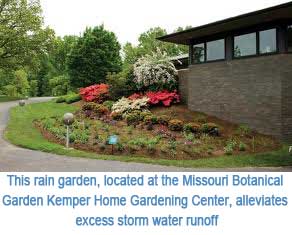Good water quality in our streams and rivers is very important to quality of life, but things as simple as storm water runoff can threaten water quality in nearby streams and rivers, even in urban areas.
 As our metropolitan areas grow, impervious surfaces, such as streets, driveways, patios and roofs, expand and collect rainwater and channel it with greater velocity; carrying soil, silt, fertilizers and oil directly to our streams and rivers. This phenomenon, if not managed properly, is detrimental to our streams and forms of animal and plants dependent on them, including humans. Rain gardens, or bio-detention, are increasingly becoming popular with homeowners, homebuilders and cities because they are individual, simple areas that control the velocity and quality of water runoff, while adding lots of natural beauty.
As our metropolitan areas grow, impervious surfaces, such as streets, driveways, patios and roofs, expand and collect rainwater and channel it with greater velocity; carrying soil, silt, fertilizers and oil directly to our streams and rivers. This phenomenon, if not managed properly, is detrimental to our streams and forms of animal and plants dependent on them, including humans. Rain gardens, or bio-detention, are increasingly becoming popular with homeowners, homebuilders and cities because they are individual, simple areas that control the velocity and quality of water runoff, while adding lots of natural beauty.
Rain gardens are feasible in any low-lying area and can be sized to accommodate individual situations. Usually a rain garden is installed in an area that is already a low, wet spot and is planted with a variety of attractive, water-loving native Missouri plants. If properly designed, the rain garden stores, naturally filters and slows the excess storm water runoff and quickly dries as the water absorbs in to the ground. These areas provide beautiful habitats for wildlife and a variety of native Missouri plants, grasses and wildflowers and are attractive, easy and functional additions to any yard or community.
 To learn more about rain gardens and planting your own, visit these great links or visit your local gardening center.
To learn more about rain gardens and planting your own, visit these great links or visit your local gardening center.
Missouri River Communities Network
For years, sewer districts, under federal pressure, have developed neighborhood and community storm water detention areas for the purpose of collecting excess runoff and metering it to the streams at slower rates. These structures are very expensive, occupy large spaces and create higher taxes; however they only manage velocity of runoff to help prevent flooding of properties downstream.
Older, established cities in inner suburban areas and urban core areas do not have water detention structures, so many are studying rain gardens and even encouraging residents to plant their own. In March 2011, the City of Maplewood decided to create their own rain garden to deal with storm water issues that were leading to flooding. Read more here.
Other cities, such as Frontenac, have adopted or are considering adopting requirements for rain gardens on infill properties when new custom homes are built or home additions add to the property’s impervious surface. Contact DH Custom Homes to find out more.

